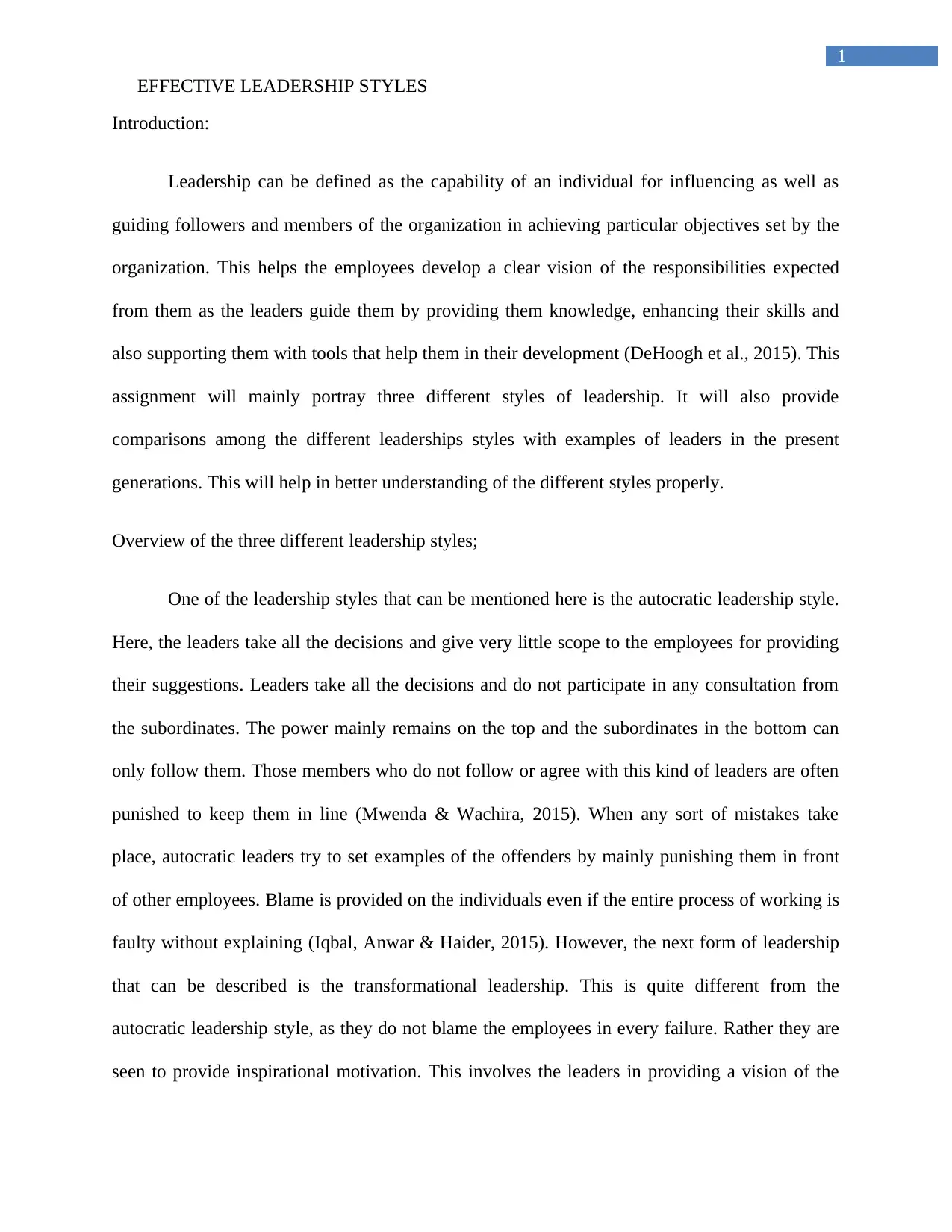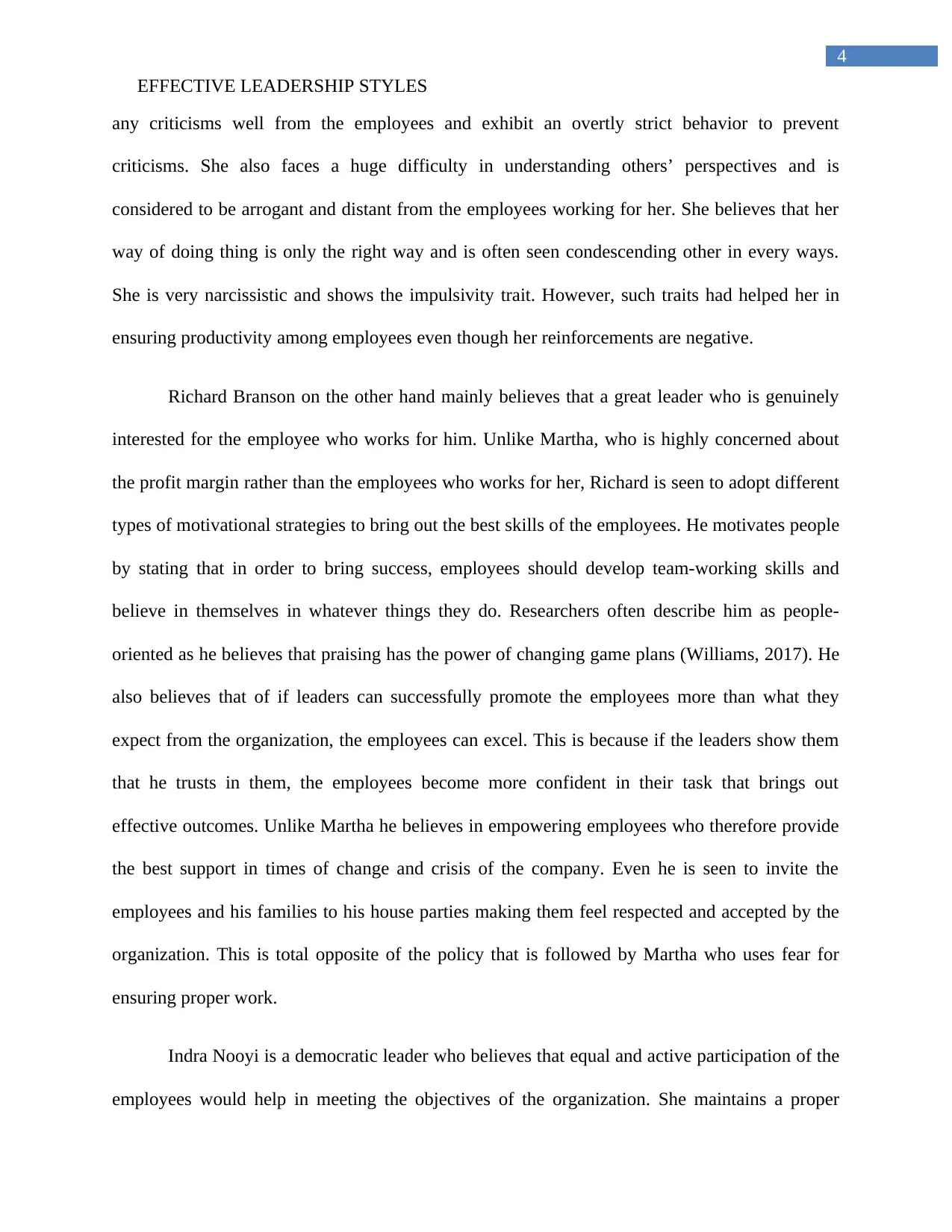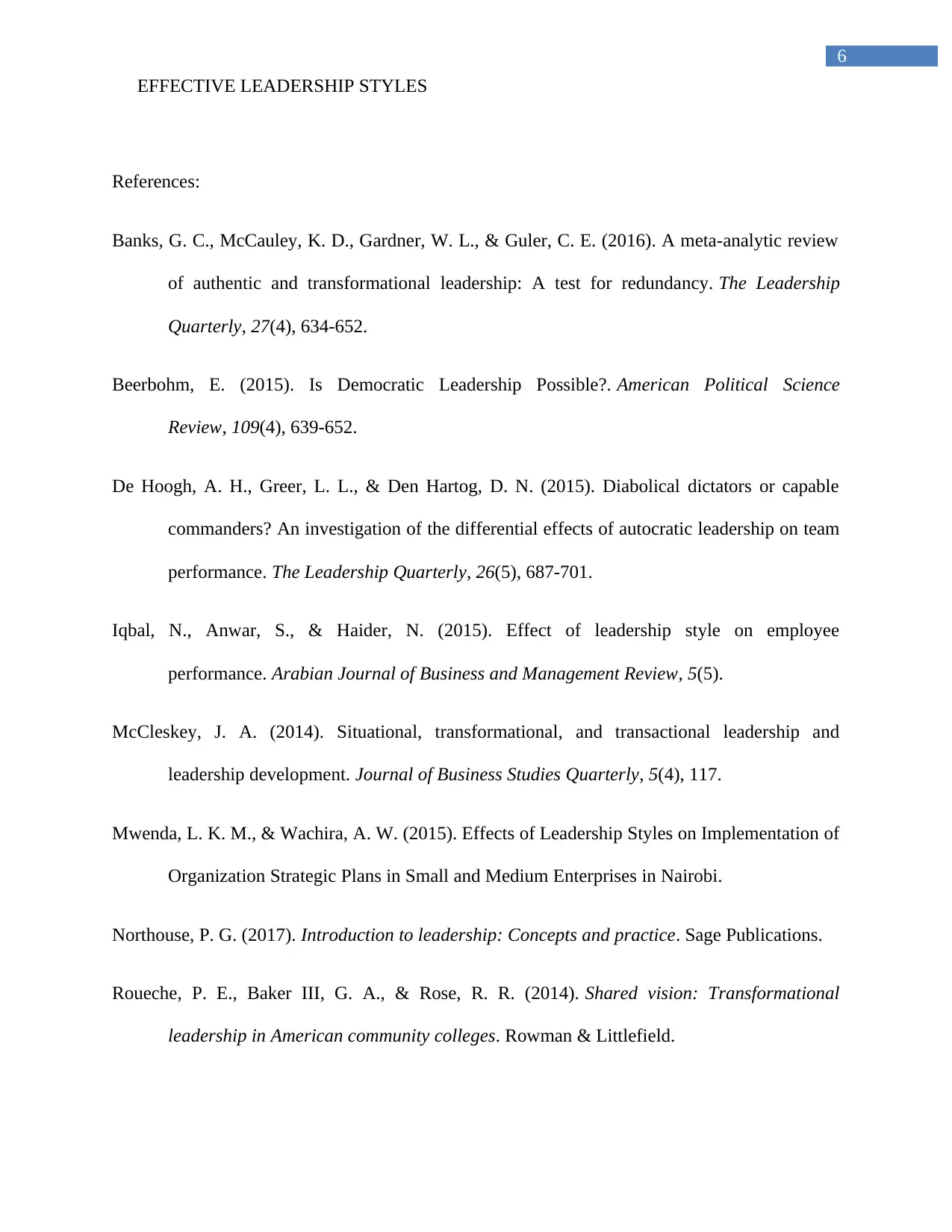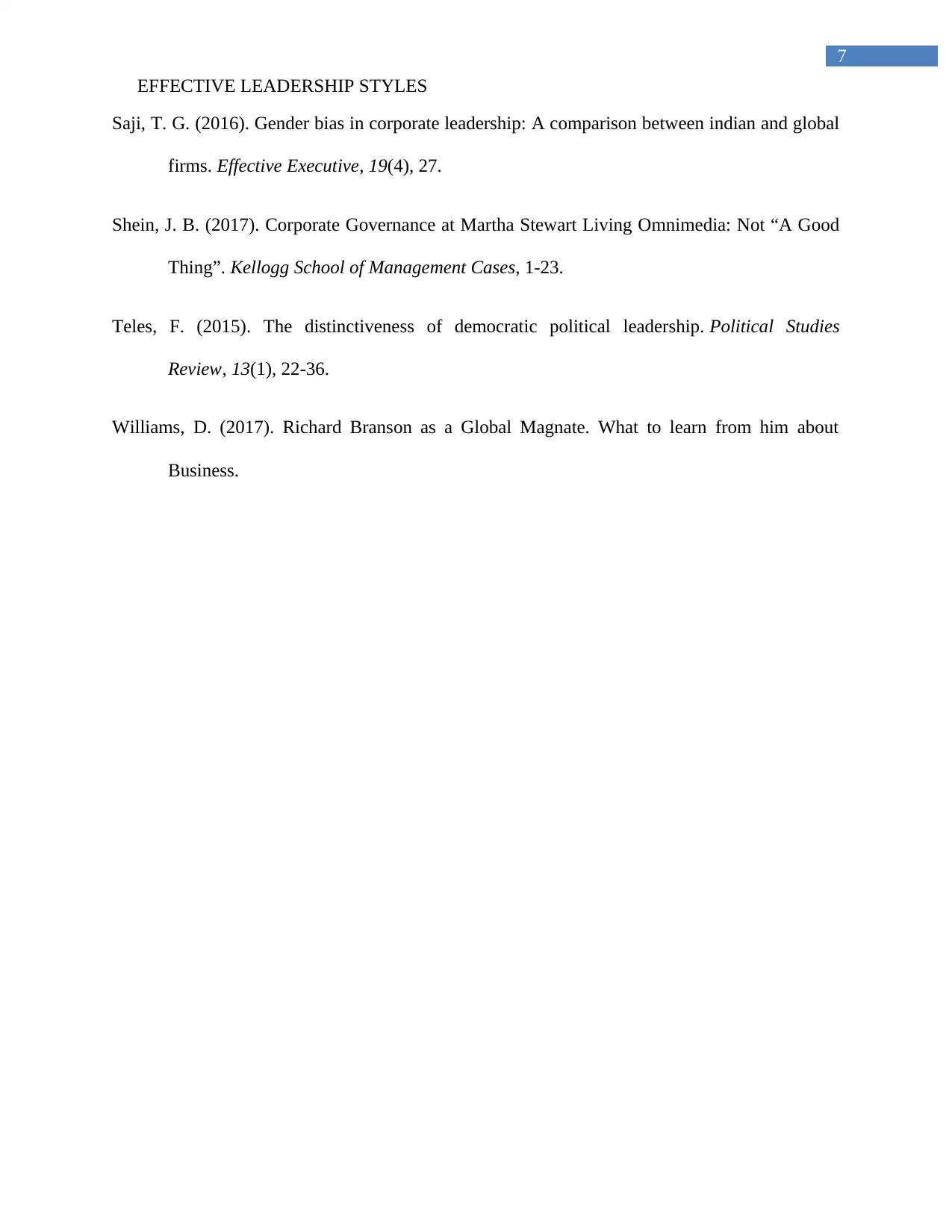Effective Leadership Styles: Autocratic, Transformational, and Democratic
VerifiedAdded on 2023/06/15
|8
|2212
|375
AI Summary
This article discusses the three different leadership styles: autocratic, transformational, and democratic. It provides comparisons among the different leadership styles with examples of leaders in the present generations.
Contribute Materials
Your contribution can guide someone’s learning journey. Share your
documents today.

Running head: EFFECTIVE LEADERSHIP STYLES
EFFECTIVE LEADERSHIP STYLES
Name of the student:
Name of the university:
Author note:
EFFECTIVE LEADERSHIP STYLES
Name of the student:
Name of the university:
Author note:
Secure Best Marks with AI Grader
Need help grading? Try our AI Grader for instant feedback on your assignments.

1
EFFECTIVE LEADERSHIP STYLES
Introduction:
Leadership can be defined as the capability of an individual for influencing as well as
guiding followers and members of the organization in achieving particular objectives set by the
organization. This helps the employees develop a clear vision of the responsibilities expected
from them as the leaders guide them by providing them knowledge, enhancing their skills and
also supporting them with tools that help them in their development (DeHoogh et al., 2015). This
assignment will mainly portray three different styles of leadership. It will also provide
comparisons among the different leaderships styles with examples of leaders in the present
generations. This will help in better understanding of the different styles properly.
Overview of the three different leadership styles;
One of the leadership styles that can be mentioned here is the autocratic leadership style.
Here, the leaders take all the decisions and give very little scope to the employees for providing
their suggestions. Leaders take all the decisions and do not participate in any consultation from
the subordinates. The power mainly remains on the top and the subordinates in the bottom can
only follow them. Those members who do not follow or agree with this kind of leaders are often
punished to keep them in line (Mwenda & Wachira, 2015). When any sort of mistakes take
place, autocratic leaders try to set examples of the offenders by mainly punishing them in front
of other employees. Blame is provided on the individuals even if the entire process of working is
faulty without explaining (Iqbal, Anwar & Haider, 2015). However, the next form of leadership
that can be described is the transformational leadership. This is quite different from the
autocratic leadership style, as they do not blame the employees in every failure. Rather they are
seen to provide inspirational motivation. This involves the leaders in providing a vision of the
EFFECTIVE LEADERSHIP STYLES
Introduction:
Leadership can be defined as the capability of an individual for influencing as well as
guiding followers and members of the organization in achieving particular objectives set by the
organization. This helps the employees develop a clear vision of the responsibilities expected
from them as the leaders guide them by providing them knowledge, enhancing their skills and
also supporting them with tools that help them in their development (DeHoogh et al., 2015). This
assignment will mainly portray three different styles of leadership. It will also provide
comparisons among the different leaderships styles with examples of leaders in the present
generations. This will help in better understanding of the different styles properly.
Overview of the three different leadership styles;
One of the leadership styles that can be mentioned here is the autocratic leadership style.
Here, the leaders take all the decisions and give very little scope to the employees for providing
their suggestions. Leaders take all the decisions and do not participate in any consultation from
the subordinates. The power mainly remains on the top and the subordinates in the bottom can
only follow them. Those members who do not follow or agree with this kind of leaders are often
punished to keep them in line (Mwenda & Wachira, 2015). When any sort of mistakes take
place, autocratic leaders try to set examples of the offenders by mainly punishing them in front
of other employees. Blame is provided on the individuals even if the entire process of working is
faulty without explaining (Iqbal, Anwar & Haider, 2015). However, the next form of leadership
that can be described is the transformational leadership. This is quite different from the
autocratic leadership style, as they do not blame the employees in every failure. Rather they are
seen to provide inspirational motivation. This involves the leaders in providing a vision of the

2
EFFECTIVE LEADERSHIP STYLES
future to the followers and at the same time motivating them for performing beyond
expectations. Another very important feature of this style of leadership is that in this type,
intellectual stimulation takes place of the old assumptions, traditions and beliefs by portraying
novel and innovative thoughts for better performance from the employees (Banks et al., 2016).
Unlike the autocratic leaders who are more concerned with the output rather than the
requirements and needs of the employees, the transformational leaders believe in individualized
considerations (McCleskey, 2014). The leaders remain highly concerned about the needs of the
people and try their best to develop the skills of their followers for better achieving of the goals.
Unlike the autocratic leaders, they do not put themselves in the topmost position and provide
more importance on what is better for the organizations. This type of leaders provides a clear
vision of the future that in turn helps in motivating staff members to perform beyond their
expectations (Rouche et al., 2014). Another form of leadership is called the democratic
leadership. Democratic leaders on the other hand are mainly seen to rely on different types of
group inputs and consensus before they are trying to make a decision. Such leaders are seen to
prefer an open discourse between the workforces (Teles, 2015). However, they make sure that
although they prefer interacting with all at equal levels, they reserve the final say. This is
different from the transformational leaders as the latter bases their leadership in motivating and
inspiring people by describing how the different changes would be helpful in benefitting the
organization before the transition initiates (Beerbobhm, 2015). Democratic leaders help the
employees in different ways by giving them the responsibility, accountability and even feedback
regarding their performance. This is also different from the autocratic leadership, as unlike
autocratic leadership, leaders do not exploit power; rather the democratic leadership believes that
relationships are very important in workplace. They place focus on the quality improvement of
EFFECTIVE LEADERSHIP STYLES
future to the followers and at the same time motivating them for performing beyond
expectations. Another very important feature of this style of leadership is that in this type,
intellectual stimulation takes place of the old assumptions, traditions and beliefs by portraying
novel and innovative thoughts for better performance from the employees (Banks et al., 2016).
Unlike the autocratic leaders who are more concerned with the output rather than the
requirements and needs of the employees, the transformational leaders believe in individualized
considerations (McCleskey, 2014). The leaders remain highly concerned about the needs of the
people and try their best to develop the skills of their followers for better achieving of the goals.
Unlike the autocratic leaders, they do not put themselves in the topmost position and provide
more importance on what is better for the organizations. This type of leaders provides a clear
vision of the future that in turn helps in motivating staff members to perform beyond their
expectations (Rouche et al., 2014). Another form of leadership is called the democratic
leadership. Democratic leaders on the other hand are mainly seen to rely on different types of
group inputs and consensus before they are trying to make a decision. Such leaders are seen to
prefer an open discourse between the workforces (Teles, 2015). However, they make sure that
although they prefer interacting with all at equal levels, they reserve the final say. This is
different from the transformational leaders as the latter bases their leadership in motivating and
inspiring people by describing how the different changes would be helpful in benefitting the
organization before the transition initiates (Beerbobhm, 2015). Democratic leaders help the
employees in different ways by giving them the responsibility, accountability and even feedback
regarding their performance. This is also different from the autocratic leadership, as unlike
autocratic leadership, leaders do not exploit power; rather the democratic leadership believes that
relationships are very important in workplace. They place focus on the quality improvement of

3
EFFECTIVE LEADERSHIP STYLES
the different systems and processes rather than on different mistakes conducted by the individual
team members.
One of the best examples of an autocratic leader is the American entrepreneur called
Martha Stewart. She is also a writer and a television personality. She is mainly the founder of the
business empire called the Martha Stewart Living Omnimedia (Shein, 2017) . She mainly helps
people by guiding them in everyday living like cooking, entertaining, renovating of homes,
gardening, holiday planning, pet, crafts and many other forms of healthy living. One of the
examples of transformational leaders is Richard Branson. He is a self-made billionaire who has
built an empire of 400 companies under the name of the Virgin group. This group includes bridal
wear, banks, mobile phones, music, hotel chains, airlines and even pension plans. His company
is one of the most recognized and respected brands in the world. One of the examples of
democratic leaders is Indra Nooyi. She is the chairperson and CEO of Pepsico since the year
2006 and is still maintaining her position with pride. The Forbes has ranked her as the thirteenth
most powerful women in the world in 2014 (Williams, 2017). All of them are effective leaders
although their leadership styles are very different.
Martha shows autocratic leadership traits where she is excessively particular as well as
demanding form her staff. Although she pays personal attention to every aspect of the business
but never provides scope for her employees to participate in decision-making. One of her
employee was quoted saying in the interviews that she treats employee as her commodity and
never tries to understand the issues faced by them (Shein, 2017). Like a good leader, she has
problem solving skills that she uses to operate a successful business and address various
challenges that act as barrier in her connecting with her audience. However, she is perfectionists
and cannot tolerate an employee who does show such traits of being perfect. She cannot handle
EFFECTIVE LEADERSHIP STYLES
the different systems and processes rather than on different mistakes conducted by the individual
team members.
One of the best examples of an autocratic leader is the American entrepreneur called
Martha Stewart. She is also a writer and a television personality. She is mainly the founder of the
business empire called the Martha Stewart Living Omnimedia (Shein, 2017) . She mainly helps
people by guiding them in everyday living like cooking, entertaining, renovating of homes,
gardening, holiday planning, pet, crafts and many other forms of healthy living. One of the
examples of transformational leaders is Richard Branson. He is a self-made billionaire who has
built an empire of 400 companies under the name of the Virgin group. This group includes bridal
wear, banks, mobile phones, music, hotel chains, airlines and even pension plans. His company
is one of the most recognized and respected brands in the world. One of the examples of
democratic leaders is Indra Nooyi. She is the chairperson and CEO of Pepsico since the year
2006 and is still maintaining her position with pride. The Forbes has ranked her as the thirteenth
most powerful women in the world in 2014 (Williams, 2017). All of them are effective leaders
although their leadership styles are very different.
Martha shows autocratic leadership traits where she is excessively particular as well as
demanding form her staff. Although she pays personal attention to every aspect of the business
but never provides scope for her employees to participate in decision-making. One of her
employee was quoted saying in the interviews that she treats employee as her commodity and
never tries to understand the issues faced by them (Shein, 2017). Like a good leader, she has
problem solving skills that she uses to operate a successful business and address various
challenges that act as barrier in her connecting with her audience. However, she is perfectionists
and cannot tolerate an employee who does show such traits of being perfect. She cannot handle
Secure Best Marks with AI Grader
Need help grading? Try our AI Grader for instant feedback on your assignments.

4
EFFECTIVE LEADERSHIP STYLES
any criticisms well from the employees and exhibit an overtly strict behavior to prevent
criticisms. She also faces a huge difficulty in understanding others’ perspectives and is
considered to be arrogant and distant from the employees working for her. She believes that her
way of doing thing is only the right way and is often seen condescending other in every ways.
She is very narcissistic and shows the impulsivity trait. However, such traits had helped her in
ensuring productivity among employees even though her reinforcements are negative.
Richard Branson on the other hand mainly believes that a great leader who is genuinely
interested for the employee who works for him. Unlike Martha, who is highly concerned about
the profit margin rather than the employees who works for her, Richard is seen to adopt different
types of motivational strategies to bring out the best skills of the employees. He motivates people
by stating that in order to bring success, employees should develop team-working skills and
believe in themselves in whatever things they do. Researchers often describe him as people-
oriented as he believes that praising has the power of changing game plans (Williams, 2017). He
also believes that of if leaders can successfully promote the employees more than what they
expect from the organization, the employees can excel. This is because if the leaders show them
that he trusts in them, the employees become more confident in their task that brings out
effective outcomes. Unlike Martha he believes in empowering employees who therefore provide
the best support in times of change and crisis of the company. Even he is seen to invite the
employees and his families to his house parties making them feel respected and accepted by the
organization. This is total opposite of the policy that is followed by Martha who uses fear for
ensuring proper work.
Indra Nooyi is a democratic leader who believes that equal and active participation of the
employees would help in meeting the objectives of the organization. She maintains a proper
EFFECTIVE LEADERSHIP STYLES
any criticisms well from the employees and exhibit an overtly strict behavior to prevent
criticisms. She also faces a huge difficulty in understanding others’ perspectives and is
considered to be arrogant and distant from the employees working for her. She believes that her
way of doing thing is only the right way and is often seen condescending other in every ways.
She is very narcissistic and shows the impulsivity trait. However, such traits had helped her in
ensuring productivity among employees even though her reinforcements are negative.
Richard Branson on the other hand mainly believes that a great leader who is genuinely
interested for the employee who works for him. Unlike Martha, who is highly concerned about
the profit margin rather than the employees who works for her, Richard is seen to adopt different
types of motivational strategies to bring out the best skills of the employees. He motivates people
by stating that in order to bring success, employees should develop team-working skills and
believe in themselves in whatever things they do. Researchers often describe him as people-
oriented as he believes that praising has the power of changing game plans (Williams, 2017). He
also believes that of if leaders can successfully promote the employees more than what they
expect from the organization, the employees can excel. This is because if the leaders show them
that he trusts in them, the employees become more confident in their task that brings out
effective outcomes. Unlike Martha he believes in empowering employees who therefore provide
the best support in times of change and crisis of the company. Even he is seen to invite the
employees and his families to his house parties making them feel respected and accepted by the
organization. This is total opposite of the policy that is followed by Martha who uses fear for
ensuring proper work.
Indra Nooyi is a democratic leader who believes that equal and active participation of the
employees would help in meeting the objectives of the organization. She maintains a proper

5
EFFECTIVE LEADERSHIP STYLES
relationship with the employees and even asks for their active participation through requests. She
has been seen to write letters to their parents thanking them for their children. Such a gesture
makes the employees happy (Saji, 2016). She looks upon all employees as equal participants and
never distinguishes between them. Just like democratic leaders, she listens to opinions and
considers all these opinions in the developing proper plans. However, she holds the authority to
make the final decisions but at the same time tries to satisfy the needs of the employees
(Northouse, 2017). However, unlike Branson, she is not seen in motivating employees with
inspirational speeches. Rather she believes in empowering employees with equal participation
and caring for them. Since, the time she became the CEO of PepsiCo, important changes have
been noticed which are high employee satisfaction, lower employee turnover and improved work
conditions.
From the entire discussion above, it becomes quite clear that different leaders have their
own leadership styles that help the organization reach the zenith of success. Autocratic leader,
like Martha Stewart likes keeping powers in her own hand and follows negative reinforcement as
the way to manage employee performance. She does not like suggestions from her employees
and treat them like commodities. This is completely opposite to that of the leadership style of
Richard Branson who follows transformational leadership style. His motivational speeches and
inspiring nature ensured him to have an empire of 400 organizations. Again, Indra Nooyi, CEO
of PepsiCo is one of the examples of democratic leaders who believes in equal participation of
the employees and introduces different ways to increase participation of employees in decision-
making. She also solves their concerns and meets their needs. Therefore, different leaders have
their own styles that have helped them to achieve success.
EFFECTIVE LEADERSHIP STYLES
relationship with the employees and even asks for their active participation through requests. She
has been seen to write letters to their parents thanking them for their children. Such a gesture
makes the employees happy (Saji, 2016). She looks upon all employees as equal participants and
never distinguishes between them. Just like democratic leaders, she listens to opinions and
considers all these opinions in the developing proper plans. However, she holds the authority to
make the final decisions but at the same time tries to satisfy the needs of the employees
(Northouse, 2017). However, unlike Branson, she is not seen in motivating employees with
inspirational speeches. Rather she believes in empowering employees with equal participation
and caring for them. Since, the time she became the CEO of PepsiCo, important changes have
been noticed which are high employee satisfaction, lower employee turnover and improved work
conditions.
From the entire discussion above, it becomes quite clear that different leaders have their
own leadership styles that help the organization reach the zenith of success. Autocratic leader,
like Martha Stewart likes keeping powers in her own hand and follows negative reinforcement as
the way to manage employee performance. She does not like suggestions from her employees
and treat them like commodities. This is completely opposite to that of the leadership style of
Richard Branson who follows transformational leadership style. His motivational speeches and
inspiring nature ensured him to have an empire of 400 organizations. Again, Indra Nooyi, CEO
of PepsiCo is one of the examples of democratic leaders who believes in equal participation of
the employees and introduces different ways to increase participation of employees in decision-
making. She also solves their concerns and meets their needs. Therefore, different leaders have
their own styles that have helped them to achieve success.

6
EFFECTIVE LEADERSHIP STYLES
References:
Banks, G. C., McCauley, K. D., Gardner, W. L., & Guler, C. E. (2016). A meta-analytic review
of authentic and transformational leadership: A test for redundancy. The Leadership
Quarterly, 27(4), 634-652.
Beerbohm, E. (2015). Is Democratic Leadership Possible?. American Political Science
Review, 109(4), 639-652.
De Hoogh, A. H., Greer, L. L., & Den Hartog, D. N. (2015). Diabolical dictators or capable
commanders? An investigation of the differential effects of autocratic leadership on team
performance. The Leadership Quarterly, 26(5), 687-701.
Iqbal, N., Anwar, S., & Haider, N. (2015). Effect of leadership style on employee
performance. Arabian Journal of Business and Management Review, 5(5).
McCleskey, J. A. (2014). Situational, transformational, and transactional leadership and
leadership development. Journal of Business Studies Quarterly, 5(4), 117.
Mwenda, L. K. M., & Wachira, A. W. (2015). Effects of Leadership Styles on Implementation of
Organization Strategic Plans in Small and Medium Enterprises in Nairobi.
Northouse, P. G. (2017). Introduction to leadership: Concepts and practice. Sage Publications.
Roueche, P. E., Baker III, G. A., & Rose, R. R. (2014). Shared vision: Transformational
leadership in American community colleges. Rowman & Littlefield.
EFFECTIVE LEADERSHIP STYLES
References:
Banks, G. C., McCauley, K. D., Gardner, W. L., & Guler, C. E. (2016). A meta-analytic review
of authentic and transformational leadership: A test for redundancy. The Leadership
Quarterly, 27(4), 634-652.
Beerbohm, E. (2015). Is Democratic Leadership Possible?. American Political Science
Review, 109(4), 639-652.
De Hoogh, A. H., Greer, L. L., & Den Hartog, D. N. (2015). Diabolical dictators or capable
commanders? An investigation of the differential effects of autocratic leadership on team
performance. The Leadership Quarterly, 26(5), 687-701.
Iqbal, N., Anwar, S., & Haider, N. (2015). Effect of leadership style on employee
performance. Arabian Journal of Business and Management Review, 5(5).
McCleskey, J. A. (2014). Situational, transformational, and transactional leadership and
leadership development. Journal of Business Studies Quarterly, 5(4), 117.
Mwenda, L. K. M., & Wachira, A. W. (2015). Effects of Leadership Styles on Implementation of
Organization Strategic Plans in Small and Medium Enterprises in Nairobi.
Northouse, P. G. (2017). Introduction to leadership: Concepts and practice. Sage Publications.
Roueche, P. E., Baker III, G. A., & Rose, R. R. (2014). Shared vision: Transformational
leadership in American community colleges. Rowman & Littlefield.
Paraphrase This Document
Need a fresh take? Get an instant paraphrase of this document with our AI Paraphraser

7
EFFECTIVE LEADERSHIP STYLES
Saji, T. G. (2016). Gender bias in corporate leadership: A comparison between indian and global
firms. Effective Executive, 19(4), 27.
Shein, J. B. (2017). Corporate Governance at Martha Stewart Living Omnimedia: Not “A Good
Thing”. Kellogg School of Management Cases, 1-23.
Teles, F. (2015). The distinctiveness of democratic political leadership. Political Studies
Review, 13(1), 22-36.
Williams, D. (2017). Richard Branson as a Global Magnate. What to learn from him about
Business.
EFFECTIVE LEADERSHIP STYLES
Saji, T. G. (2016). Gender bias in corporate leadership: A comparison between indian and global
firms. Effective Executive, 19(4), 27.
Shein, J. B. (2017). Corporate Governance at Martha Stewart Living Omnimedia: Not “A Good
Thing”. Kellogg School of Management Cases, 1-23.
Teles, F. (2015). The distinctiveness of democratic political leadership. Political Studies
Review, 13(1), 22-36.
Williams, D. (2017). Richard Branson as a Global Magnate. What to learn from him about
Business.
1 out of 8
Related Documents
Your All-in-One AI-Powered Toolkit for Academic Success.
+13062052269
info@desklib.com
Available 24*7 on WhatsApp / Email
![[object Object]](/_next/static/media/star-bottom.7253800d.svg)
Unlock your academic potential
© 2024 | Zucol Services PVT LTD | All rights reserved.





